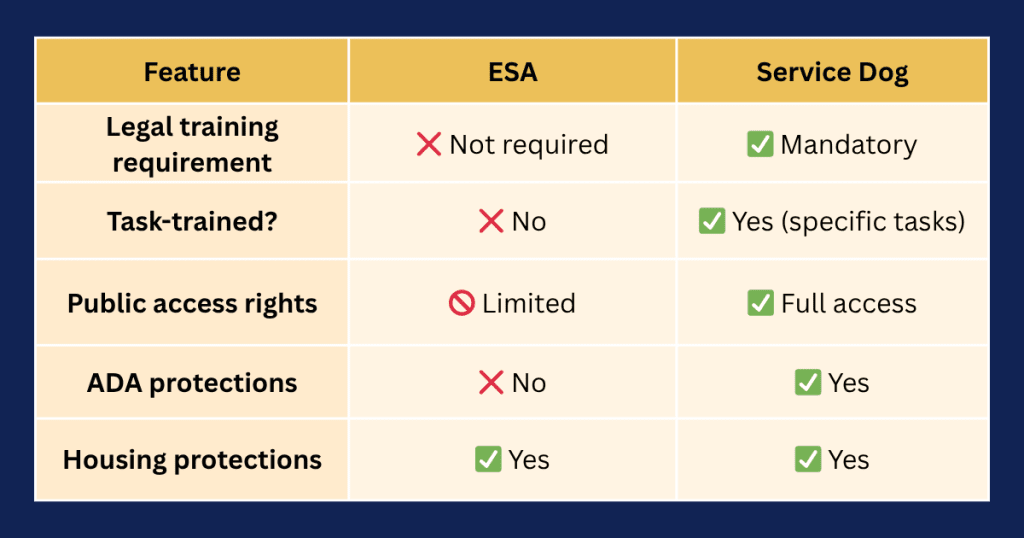Emotional support animals don’t need special training by law—but thoughtful behavior, structure, and mutual respect still go a long way. The presence of a loving animal can quietly yet powerfully transform daily living. But even the most nurturing of bonds benefit from guidance. And when it comes to emotional support animals (ESAs), the question of training isn’t always as straightforward as it seems.
Key Takeaways
- ESA training is not legally required under the Fair Housing Act, but landlords can deny housing if your ESA is disruptive or aggressive.
- Basic obedience helps emotional support animals thrive by creating structure, building trust, and reducing behavioral issues.
- Respectful behavior in shared spaces matters—an ESA that stays calm and composed is more likely to be accepted by neighbors and property managers.
- Training deepens the bond between ESA and owner, offering emotional stability for both, even without formal requirements.
- Working with a professional trainer can be valuable, especially if your ESA has behavioral challenges or you need extra guidance.
Are Emotional Support Animals Legally Required to Be Trained?
Short answer: No, but there’s nuance.
There’s no federal mandate saying your ESA must complete training classes or pass a behavior test. That’s because ESAs are protected under the Fair Housing Act (FHA)—not the Americans with Disabilities Act (ADA), which covers service dogs.
Under the FHA, landlords must accommodate individuals with emotional or psychological disabilities who rely on an ESA. Unlike service dogs, ESAs don’t need to perform specific tasks or undergo specialized instruction. But here’s where things get misunderstood: legal protection isn’t a license for chaos.
A common myth is that buying a certificate online makes your dog an ESA. It doesn’t. What you do need is a legitimate ESA letter from a licensed mental health professional. That letter confirms the need, not the training.
So no, there’s no formal requirement. But the absence of obligation doesn’t mean we should skip the opportunity to guide, nurture, and shape our animal companions with intention.
Why ESA Training Still Matters (Even If It’s Not Required)
Just because training isn’t legally mandated doesn’t mean it’s irrelevant. In fact, a little effort can dramatically improve life for both you and your ESA.
- In housing situations, calm, well-adjusted animals are more likely to be welcomed—and less likely to draw complaints or trigger pet policies.
- When traveling, even though ESAs are no longer guaranteed access to airplane cabins, well-mannered animals are often met with greater flexibility and grace.
- For your own well-being, predictable routines and responsive behavior provide comfort and confidence.
- In shared living spaces, an ESA that respects boundaries and stays composed will naturally gain more goodwill from roommates, neighbors, and property managers.
Good training isn’t about control. It’s about trust. It says, “You’re safe with me—and I trust you to keep me safe, too.”
Essential Behaviors Every ESA Should Learn

Training doesn’t need to be elaborate. But a few foundational behaviors can make all the difference in your ESA’s ability to thrive in daily life.
Basic Obedience Commands
Commands like “sit,” “stay,” “come,” and “leave it” create structure and help in moments of uncertainty. Even something as simple as loose leash walking can elevate a daily walk into a therapeutic rhythm.
Housebreaking and Indoor Manners
No one enjoys surprises in the hallway or shredded mail by the door. Potty training, crate comfort, and minimal barking are key for apartment life and long-term housing security.
Socialization and Temperament
An ESA doesn’t need to be a social butterfly—but calmness around other people, pets, and new environments is essential. Over time, that confidence becomes mutual.
Respect for Boundaries and Personal Space
Especially in shared spaces, it’s important that your ESA understands when to approach—and when to hang back. Respect is a two-way street, and animals can absolutely learn that.
Emotional Support Animal vs. Service Dog Training
Let’s clear up one of the biggest sources of confusion: ESA training isn’t the same as service dog training—and it’s not supposed to be.

Legal training requirement
Service animals are defined by what they do. They’re trained to perform tasks that mitigate a disability. ESAs are valued for what they are—a steady, healing presence.
Task-trained
A service dog might guide someone who’s blind, detect seizures, or interrupt self-harm. ESAs don’t perform tasks but offer unconditional comfort and emotional grounding.
Public access rights
ESAs don’t have the right to enter restaurants, retail stores, or public spaces where pets are prohibited. And that’s okay—because their superpower happens quietly, in private moments.
ADA protections
Only service animals are protected by the ADA. Emotional support animals are not guaranteed access to public places.
Housing protections
ESAs are protected under the FHA, which means they can live in “no pets” housing with a valid letter. That protection is powerful—but it can be revoked if the animal behaves poorly.
How to Train an Emotional Support Animal
Can You Train Your ESA at Home?
Absolutely. In fact, many of the best trainers start right in the living room. Use positive reinforcement—treats, praise, play. Stay consistent, keep sessions short, and celebrate progress.
Working With a Professional Trainer
Sometimes a little extra help goes a long way. Look for someone who uses force-free, positive methods, and ideally has experience working with ESA-type cases. Prices vary but expect to invest anywhere from $75–$150/session depending on location.
How Long Does ESA Training Take?
There’s no single answer here. Some pups take to training like ducks to water. Others need time, especially if they’ve had trauma or inconsistent routines in the past. It’s a journey, not a sprint.
Do All ESAs Need to Be Dogs?
Nope. While dogs are the most common, emotional support animals can include cats, birds, rabbits, even mini pigs—as long as they meet the emotional need and aren’t disruptive.
Training a cat? Focus on litter box use and calm behavior. Got a bird? Minimize squawking and biting. Rabbits? Litter train and socialize early. Just remember: every species communicates differently. But they all respond to trust.
What Happens If an ESA Is Disruptive or Aggressive?
Here’s where things get delicate.
- Landlords have rights, too. Under the FHA, they can deny or evict an ESA if it’s dangerous, causes damage, or disrupts neighbors.
- Paperwork won’t protect behavior. A letter won’t excuse biting, barking, or destruction.
- If things go sideways, communicate. Be honest, proactive, and open to compromise.
- Consider mediation or professional help before the situation escalates.
Your ESA’s role is to support your mental health—not jeopardize your living situation.
My ESA Is Already Well-Behaved—Do I Still Need Training?

Even mellow animals benefit from structure. Formal training:
- Deepens your bond, especially with adopted pets or new companions
- Builds confidence for both pet and handler
- Prevents future issues through proactive behavior shaping
Training isn’t about changing your ESA—it’s about honoring them with attention, focus, and mutual understanding.
Legal and Practical Tips for ESA Owners
- Keep your ESA letter up to date, especially when moving or renewing leases.
- Communicate early with landlords or roommates to set expectations.
- Know your rights—and your responsibilities. Housing protections are strong, but not unlimited.
- Consider pet insurance or renter’s insurance in case of accidental damage.
A little prep now can spare a lot of headaches later.
Do Emotional Support Animals Need Training?
We believe in emotional support animals not just because the law says they matter—but because we’ve seen the difference they make. The wag of a tail during hard days. The quiet comfort of soft fur beneath your hand. The grounding presence when everything else feels unsteady.
While training may not be required, it’s one of the kindest gifts we can offer in return. A well-behaved ESA isn’t just easier to live with—it’s a better companion, a trusted anchor, and a reminder that love, when nurtured, can become a kind of strength.
At Emma & Buddy, we’re here to help you navigate every step of the ESA journey—with style, care, and heart.











